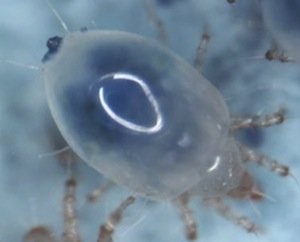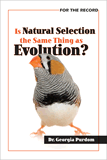
Evolutionary Changes Said to Offer Insight on Wildlife
Rapidly occurring “hard-wired evolutionary changes” said to offer game-changing insights for wildlife management.
News Source
- ScienceDaily: “Environmental Change Triggers Rapid Evolution”
Ecology Letters has just published the first study to clearly demonstrate, according to the authors, that environmental change can directly cause rapid “evolution” of animals. They say this is an “example of evolutionary rescue”1 in a population threatened with extinction. The authors believe the changes they observed in soil mites should help “predict species responses over ecological or evolutionary timescales”1 and fulfill the “need to bring evolutionary biology into population management”1 of fisheries and wildlife.
 Soil mite populations adjusted to harsh selection pressures imposed in the laboratory by altering their rate of maturation and fertility. Yet despite this adaptation, they remained soil mites. Image: Umeå universitet through www.sciencedaily.com
Soil mite populations adjusted to harsh selection pressures imposed in the laboratory by altering their rate of maturation and fertility. Yet despite this adaptation, they remained soil mites. Image: Umeå universitet through www.sciencedaily.com
The animal studied is the Sancassania berlesei soil mite—a tiny invertebrate that lives in dirt. University of Leeds professor Tim Benton and his team raised populations of soil mites in glass tubes with limited resources. In some tubes they removed nearly half of the adults every week, and in some they culled nearly half of the juveniles. They monitored the effect of this “decimation” on the population. At first the mite populations decreased on a trajectory toward “extinction.” But then, within just fifteen generations, the demographics and reproductive behavior of the mites began to change. As a result of the selection pressure placed on the populations, the mites nearly doubled in the time to maturity. And upon reaching maturity, these slow-growing mites were unusually fertile.
“We saw significant evolutionary changes relatively quickly. The age of maturity of the mites in the tubes doubled over about 15 generations, because they were competing in a different way than they would in the wild,” lead author Tom Cameron explains. “Removing the adults caused them to remain as juveniles even longer because the genetics were responding to the high chance that they were going to die as soon as they matured. When they did eventually mature, they were so enormous they could lay all of their eggs very quickly.” Adding the evolutionary angle, Cameron says, “The genetic evolution that resulted in an investment in egg production at the expense of individual growth rates led to population growth, rescuing the populations from extinction. This is evolutionary rescue in action and suggests that rapid evolution can help populations respond to rapid environmental change.”
“This demonstrates that short-term ecological change and evolution are completely intertwined and cannot reasonably be considered separate,” Benton explains. “We found that populations evolve rapidly in response to environmental change and population management. This can have major consequences such as reducing harvesting yields or saving a population heading for extinction.”
Distinguishing this from ordinary population adjustments in response to environmental stressors, Benton says, “The traditional idea would be that if you put animals in a new environment they stay basically the same but the way they grow changes because of variables like the amount of food. However, our study proves that the evolutionary effect—the change in the underlying biology in response to the environment—can happen at the same time as the ecological response. Ecology and evolution are intertwined.”
Based on this sort of information, those who manage fisheries may be able, the authors believe, to make more informed decisions by understanding the impact of those decisions on fish populations.
Based on this sort of information, those who manage fisheries may be able, the authors believe, to make more informed decisions by understanding the impact of those decisions on fish populations, their environment, and even the characteristics of the fish themselves. North Sea cod have, over the past fifty years, begun maturing at half their previous size and become less fertile. Pointing out relevance of the “eco-evolutionary response”2 to analyzing the cod problem, Benton says, “The big debate has been over whether this is an evolutionary response to the way they are fished or whether this is, for instance, just the amount of food in the sea having a short-term ecological effect. Our study underlined that evolution can happen on a short timescale and even small 1 to 2 per cent evolutionary changes in the underlying biology caused by your harvesting strategy can have major consequences on population growth and yields. You can't just try to bring the environment back to what it was before and expect everything to return to normal.”
This nicely done controlled study demonstrates the potential that created kinds of animals have to vary and adapt, thus producing in a short time animals that are very different from their ancestors. Yet, obviously, all the variations result in organisms that are still soil mites. The variations observed here are simply options available within the soil mite population, as those individuals that mature more slowly and are more fertile were selected to survive and reproduce.
Nothing about these variations suggests that the mites have acquired the genetic information to become non-mites. And nothing in the field of evolutionary biology has ever demonstrated that such a new kind of organism could thus evolve. These mites, like all created animals, reproduced in the way the Bible says—“after their kinds.”
The use of the “E-word” among evolutionists is very slippery, implying that because observable variations can happen in “ecological time” more dramatic evolutionary transitions to new, more complex kinds of animals could happen over “evolutionary time.” While variations are observable, evolution of new kinds is not and would require entirely different (and non-existent) genetic mechanisms.
This study may contribute to a more scientific approach to fish and wildlife management, but it does nothing to lend credence to evolutionary dogma. Neither does it demonstrate any need for principles of “evolutionary biology,” as only the ordinary observable principles of biology and genetics affected the results.
Further Reading
- Do Species Change?
- Pigeon’s Crest Genome Mutation Produces Biodiversity (pigeon evolution)
- Dust Mites Defy Dollo’s Law (reverse evolution)
- Humps May Have Been Key to Ancient Camel’s Arctic Survival (Arctic camel)
- Interpreting an Unusual Arctic Bear within a Creation Model of Origins
- Rapid Speciation
- Is Natural Selection the Same Thing as Evolution?
For More Information: Get Answers
Remember, if you see a news story that might merit some attention, let us know about it! (Note: if the story originates from the Associated Press, FOX News, MSNBC, the New York Times, or another major national media outlet, we will most likely have already heard about it.) And thanks to all of our readers who have submitted great news tips to us. If you didn’t catch all the latest News to Know, why not take a look to see what you’ve missed?
(Please note that links will take you directly to the source. Answers in Genesis is not responsible for content on the websites to which we refer. For more information, please see our Privacy Policy.)
Footnotes
- T. Cameron et al., “Eco-evolutionary dynamics in response to selection on life-history,” Ecology Letters (2013) onlinelibrary.wiley.com/doi/10.1111/ele.12107/abstract
Recommended Resources

Answers in Genesis is an apologetics ministry, dedicated to helping Christians defend their faith and proclaim the good news of Jesus Christ.
- Customer Service 800.778.3390
- Available Monday–Friday | 9 AM–5 PM ET
- © 2025 Answers in Genesis




